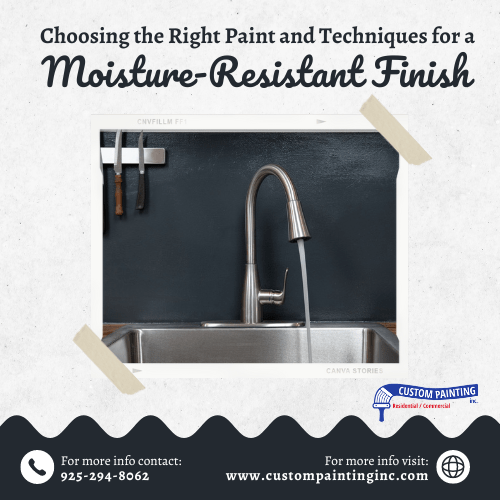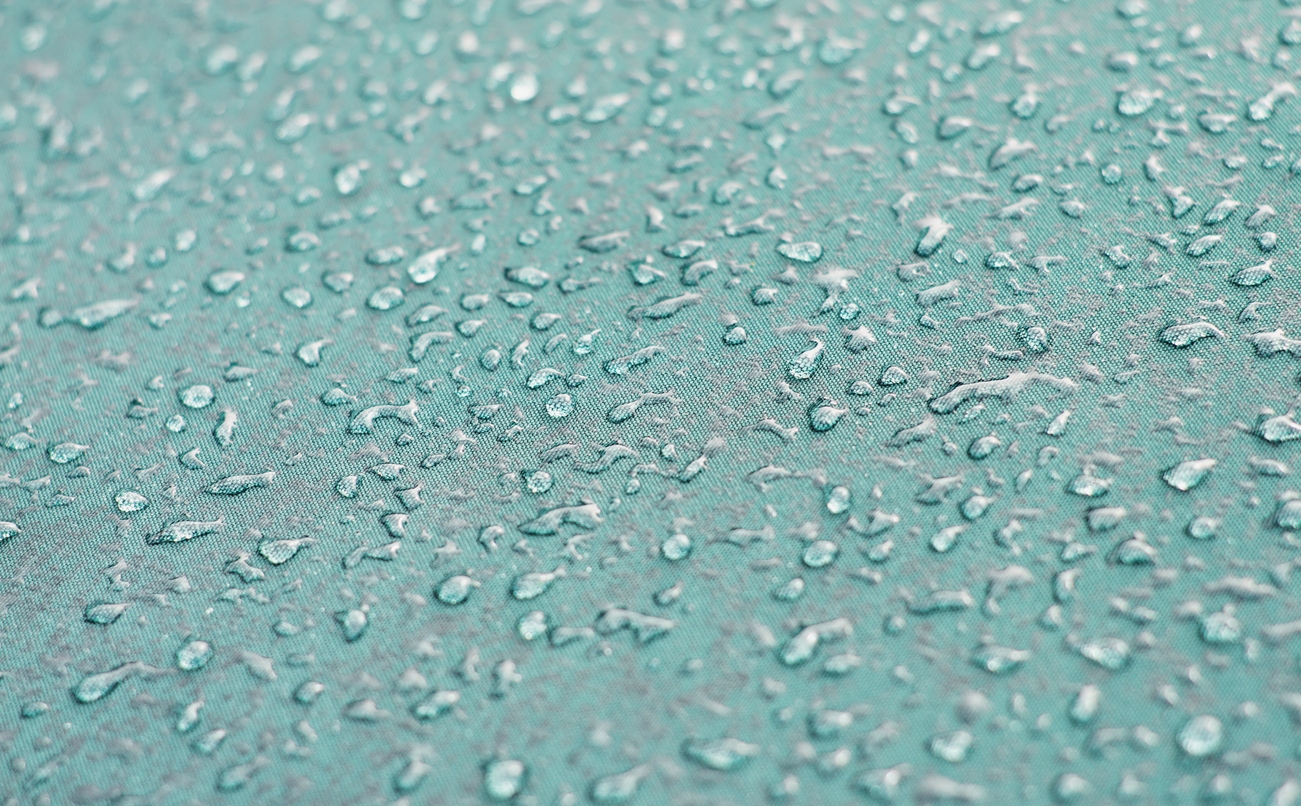Selecting the right paint and techniques for a moisture-resistant finish is a great way to maintain areas that are exposed to high humidity and water. Spaces like bathrooms, kitchens, and basements are particularly vulnerable to moisture. Too much moisture can then lead to mold and paint damage.
Using the appropriate products and methods can protect these surfaces and ensure they remain durable and appealing. This article will guide you on how to choose the best paint and apply it effectively to create a moisture-resistant finish in your home.
Understanding Moisture and Its Effects
Moisture can have a big impact on various surfaces in your home. On walls, moisture can seep into the paint and drywall, causing bubbling and peeling. Over time, this can lead to mold growth, which not only looks bad but can also affect your health.
Wood is also highly susceptible to moisture. When exposed to high humidity or water, wood can warp, swell, or rot, weakening the structural integrity of wooden elements in your home, like beams and floors.
Metal surfaces are not immune to moisture either. Prolonged exposure can cause rust and corrosion, compromising the strength and appearance of metal fixtures and fittings.
Common problems caused by moisture include mold growth, which thrives in damp environments and can spread quickly. Peeling paint is another issue, as moisture undermines the adhesive properties of paint, causing it to lift and crack. Structural damage is a severe consequence, particularly with wood and metal, where the material can weaken to the point of failure.
Types of Moisture-Resistant Paints
Here are some types of moisture-resistant paints and their best applications:
Acrylic Paints
Acrylic paints are water-based and known for their durability and resistance to moisture. They dry quickly and form a flexible, protective layer that can withstand humid conditions. These paints are also easy to clean, making them ideal for areas prone to dirt and grime.
Best applications for acrylic paints include kitchens, bathrooms, and basements. Their resistance to moisture makes them perfect for areas where humidity is a concern.
Epoxy Paints
Epoxy paints are known for their excellent adhesion and strong resistance to moisture and chemicals. They form a hard, durable surface that is highly resistant to wear and tear. Epoxy paints are also resistant to mold and mildew, making them ideal for damp environments.
Best applications for epoxy paints include garages, basements, and commercial kitchens. Their toughness makes them suitable for high-traffic areas and surfaces exposed to harsh conditions. Epoxy paints are particularly effective on floors and metal surfaces.
Oil-Based Paints
Oil-based paints offer a hard, durable finish that is resistant to moisture. They take longer to dry compared to water-based paints but provide a smoother and more resilient surface. Oil-based paints are also resistant to chipping and peeling, making them a good choice for high-humidity areas.
Best applications for oil-based paints include trim, doors, and cabinets. Their durability and moisture resistance make them suitable for areas that require a tough, long-lasting finish. However, they can emit strong fumes, so proper ventilation is necessary during application.
Specialty Moisture-Resistant Paints
Specialty moisture-resistant paints, such as anti-condensation and waterproofing paints, offer specific protection against moisture issues. Anti-condensation paints contain insulating properties that reduce the likelihood of condensation forming on surfaces. Waterproofing paints create an impermeable barrier that prevents water from penetrating the surface.
The best applications for specialty paints are basements, bathrooms, and exterior walls. Anti-condensation paints are ideal for areas where condensation is a problem while waterproofing paints are perfect for surfaces exposed to direct water contact.
Preparing Surfaces for Painting
Getting surfaces ready for painting is a key step to ensure a smooth and durable finish. Proper preparation can make a big difference in the final look. Here are the steps to follow:
- Clean the Surface: Remove dirt, grease, and grime using soap and water or a cleaner. A clean surface helps the paint adhere better.
- Repair Any Damage: Fill holes, cracks, and dents with spackling or filler. Once dry, sand the repaired areas smoothly.
- Sand the Surface: Lightly sand the entire surface to create a smooth base for the paint. This helps the paint stick better and results in a more even finish.
- Remove Dust: Wipe away any dust from sanding with a damp cloth or tack cloth. Dust can prevent paint from adhering properly.
- Prime the Surface: Apply a coat of primer to the surface. Primer helps the paint adhere better and provides a uniform base, especially on repaired or bare areas.
- Tape and Cover: Use painter’s tape to protect edges and trim. Cover floors, furniture, and fixtures with drop cloths or plastic sheeting to protect them from paint splatters.
Painting Techniques for Maximum Moisture Resistance
Using the right painting techniques is essential for achieving maximum moisture resistance. Here are some key factors to consider:
Proper Application Methods
Using the right tools is important. Brushes are great for detailed work and edges, while rollers are ideal for covering large, flat surfaces quickly. Spray techniques can provide a smooth, even finish, especially on textured surfaces. Ensure an even coating and allow adequate drying times between coats to prevent moisture from being trapped.
Layering and Coating
Applying multiple coats of paint enhances protection against moisture. Start with a good primer to create a strong base, especially on new or repaired surfaces. After the primer, apply at least two coats of paint. For added protection, consider using a sealer as the final layer.
Special Considerations
When painting in high-humidity environments, choose paints specifically designed for such conditions. Humidity can affect drying times and the finish, so it’s important to follow the manufacturer’s guidelines. Also, consider the season and weather when planning your project, as temperature and humidity levels can impact the painting process and results.
Maintenance and Long-Term Care
Here are some tips to help you maintain and care for your painted surfaces:
- Regular Cleaning: Wipe down surfaces regularly with a damp cloth to remove dirt and grime. Use mild soap if needed, but avoid harsh chemicals that can damage the paint.
- Touch Up as Needed: Keep some leftover paint for touch-ups. Address chips and scratches promptly to prevent moisture from penetrating the surface.
- Control Humidity: Use dehumidifiers or exhaust fans in areas prone to moisture, like bathrooms and kitchens. This helps reduce the overall humidity and protects the paint.
- Inspect for Mold and Mildew: Check for mold and mildew regularly, especially in damp areas. Clean any spots with a mild bleach solution to prevent them from spreading.
- Avoid Excessive Water: Protect painted surfaces from excessive water exposure. Wipe up spills immediately and use coasters or mats to protect surfaces from standing water.
- Repaint When Necessary: Over time, even the best paint job may need refreshing. Plan to repaint high-moisture areas every few years to keep them looking fresh and protected.
Conclusion
Choosing the right paint and techniques for a moisture-resistant finish is key to protecting your home from the effects of humidity and water exposure. By preparing surfaces properly, selecting the appropriate paint, and applying it correctly, you can achieve a durable and attractive finish.
For professional help with moisture-resistant painting, contact Custom Painting, Inc. Call us at 925-686-0903 or fill out a Contact Form on our website. We’re here to ensure your painting project is a success.



